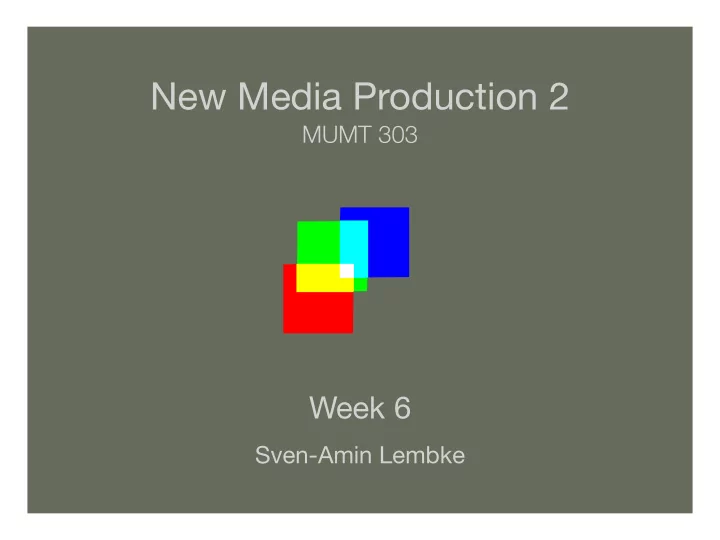

New Media Production 2 MUMT 303 Week 6 Sven-Amin Lembke
Granular synthesis
Grains • based on sound grain defined by ... • amplitude envelope ... ‣ duration typically 5-50 ms • envelope shape: ‣ Gaussian, Tukey, v. Hann ‣ triangular, trapezoidal ‣ decaying exponential • grain content: ‣ any waveform
Granular synthesis: history • Dennis Gabor, electrical engineer and physicist ‣ in 1940s developed theory that any sound can be described by granular or quantum representation ‣ established term of acoustical quanta • Gabor’s theory taken up by other persons ... ‣ in 1964 Wiener supported quantum view of sound ‣ in 1968 Moles derived first physical representation ‣ in 1980 Bastiaans verified theory mathematically
Granular synthesis: in music • Iannis Xenakis, composer and architect-engineer • first to use granular techniques in musical contexts, using magnetic tape manipulation: ‣ Concret PH 1958 ‣ Analogique A et B 1958-59 • formalized compositional theory for grains of sound: ‣ Formalized Music 1971
Granular synthesis: in music “All sound, even continuous musical variation, is conceived as an assemblage of a large number of elementary sounds adequately disposed in time . In the attack, body, and decline of a complex sound, thousands of pure sounds appear in a more or less short interval of time Δ t.” - Xenakis
Granular synthesis: in music • Curtis Roads, composer and granular pioneer • created first computer-based synthesis implementation: ‣ at UCSD in 1974 and MIT in 1981 ‣ implemented as front-end processor to MUSIC V • contributed documentation of methods: ‣ articles in Computer Music Journal ‣ book Microsound 2001
Granular synthesis: in music • Barry Truax, composer • developed first real-time synthesis implementation in 1986: ‣ using DMX-100 digital signal processor ‣ allowed up to 20 simultaneous voices (polyphony) • approach seen as a form of real-time composition: ‣ Riverrun 1986
Granular synthesis: in music "The fundamental paradox of granular synthesis--- that the enormously rich and powerful textures it produces result from its being based on the most 'trivial' grains of sound---suggested a metaphoric relation to the river whose power is based on the accumulation of countless 'powerless' droplets of water ." - Truax
Granular synthesis: in music • Jones and Parks experimented with grains containing recorded samples: ‣ granulation seen as decomposition of sampled sounds into grain sequences ‣ experimented with time-frequency manipulations • Risset and Wessel in 1982 worked with granular methods in a analysis/synthesis system • related developments in other fields: ‣ wavelet-transform, developed at Center for Theoretical Physics in Marseille, France ‣ particle-synthesis, developed by Reeves in 1983
Granular synthesis: methods • Simple definition of granular techniques difficult: ‣ no standard implementation ‣ no relationship to classical signal processing synthesis techniques • Two main groups for synthesis approaches: ‣ synchronous granular synthesis ‣ asynchronous granular synthesis
Synchronous granular synthesis • Synchronous synthesis involves repetition of grains at a constant rate. • Inherently corresponds to amplitude-modulation (AM) ... ‣ modulator: grain envelope at repetition rate ‣ carrier: grain content (waveform inside grain) ‣ generates sidebands in spectrum • Applications in speech synthesis: ‣ FOF ( fonction d’onde formantique ) ‣ VOSIM, voice synthesizer
Synchronous granular synthesis • AM involved with synchronous synthesis ... ‣ determined by grain length, repetition rate and envelope shape
Asynchronous granular synthesis • Asynchronous synthesis involves random distribution of grain timing. • Instead of controlling parameters ‘grain-to-grain’, higher-level control of parameters often employed
Asynchronous granular synthesis • There is a multitude of approaches for higher-level controls of grain parameters: ‣ Wishart: texture manipulation ‣ GRM: brassage ‣ Roads: events ‣ Xenakis: screens ‣ Truax: tendency masks
Asynchronous granular synthesis • Still, there are commonalities across asynchronous synthesis approaches ... • in generating so-called clouds
Asynchronous granular synthesis • Still, there are commonalities across asynchronous synthesis approaches ... • in generating so-called clouds Truax, 1986: Riverrun
Asynchronous granular synthesis • Commonalities across asynchronous synthesis approaches ... • employing common controls parameters ... ‣ grain envelope ‣ grain content ‣ pitch and amplitude ‣ grain density (delay and length) ‣ spatialization
Granular synthesis and perception • Truax discusses psychoacoustical variables involved with granular synthesis ... • pitch to noise continuum • temporal spacing between grains ‣ <50 ms continuous texture ‣ >50 ms separate events • (isolated) sound grains ... ‣ preclude pitch percept if <13 ms ‣ only exhibit emergent timbre for >40-50 ms
Recommend
More recommend